Medicare Coverage for Eyelid Surgery
You may be overwhelmed by the complexities of Medicare and Private health insurance. Knowledge of Medicare can aid in your understanding of how it works. Medicare is a government-funded health care system that provides Australian citizens and most permanent residents with access to a broad range of health services at low or no cost. Medicare offers a comprehensive range of services, including hospital treatment, medical services, and prescription medicines. Your understanding of our Medicare system is crucial, especially when considering treatments like eyelid surgery. This blog aims to highlight whether Medicare covers eyelid surgery and how to navigate the process.
Dr Michael Kernohan has an impressive array of qualifications, including MBBS, MSc, BDS, FDSRCS, FRCS (Plast), and FRACS (Plast). He employs different plastic surgery techniques, always prioritising patient care and ethical considerations. Beyond his surgical expertise, Dr Kernohan and his team at the cosmetic clinic are dedicated to enhancing the overall patient experience, ensuring a smooth journey from the initial consultation to post-surgery care.
Click to Download Dr Michael Kernohan Facial Rejuvenation Guide

What Are Medicare Item Numbers?
To understand Medicare Australia better, you need to familiarise yourself with Medicare Item Numbers. These are numerical codes assigned to specific medical services, procedures, and consultations. Each item number corresponds to a specific benefit amount that Medicare will reimburse.
Medicare Item Numbers are essential as they determine the reimbursement you can receive from Medicare for a particular service. However, keep in mind that not all services or procedures have an item number. If a procedure does not have an item number, it means it is not recognised by Medicare, and therefore, you cannot claim any benefits for it.
Coverage of Medicare Australia: What does it include?
Medicare Australia offers a wide range of coverage, from general practitioner visits to specialist consultations, diagnostic imaging, pathology, and surgical procedures. It also covers some dental work, eye tests, and most vaccinations. But the exact coverage depends on the Medicare Item Number attached to the service or procedure.
Although Medicare is comprehensive, it does not cover everything. For example, it does not cover cosmetic surgery procedures, private hospital costs, and overseas medical treatment. Therefore, it’s crucial to check whether Medicare covers a particular service or procedure before undergoing it to avoid any unexpected out-of-pocket expenses.
What Is Eyelid Surgery?
Eyelid surgery is a surgical procedure that corrects defects, deformities, and disfigurations of the eyelids. It also modifies the eye region of the face to aesthetically enhance it. This procedure can be both a functional and cosmetic surgery, depending on the patient’s needs and the plastic surgeon’s judgment.
Eyelid surgery can address various issues, such as drooping eyelids, excess skin or wrinkles around the eyes, and puffiness or bags under the eyes. It can significantly improve your vision and appearance. But like any surgical procedure, it comes with potential risks and complications, so it’s crucial to discuss these with Dr Kernohan before deciding on the surgery.
Medicare for Eyelid Surgery – What you need to know
A popular question is “does Medicare Australia cover eyelid surgery”? The answer is, “it depends”. Medicare will cover eyelid surgery if it’s deemed medically necessary, i.e., it significantly impairs your vision. In such cases, Medicare considers the procedure reconstructive rather than cosmetic.
The key to getting your eyelid surgery covered by Medicare lies in the Medicare Item Numbers. For example, Item Number 45617 is for upper eyelid surgery necessary due to visual impairment, and Item Number 45620 is for lower eyelid surgery for the same reason. Remember, you will need to demonstrate the medical necessity of the procedure for Medicare to cover it. This will require a vision assessment from an Opthamologist.
Item Numbers for Blepharoplasty
To claim benefits for blepharoplasty, you need to know the correct Medicare Item Numbers. As mentioned earlier, Item Number 45617 is for upper eyelid surgery, while Item Number 45620 is for lower eyelid surgery.
When a medical condition necessitates the reduction of one eyelid, a corresponding procedure might be required on the opposite eyelid to maintain balance. This subsequent operation would also be eligible for benefits.
Medicare does not cover procedures purely for cosmetic purposes. Comprehensive clinical records, including distinct photographic proof of eyelid skin overlapping the lashes during a relaxed forward gaze leading to vision obstruction, must be maintained. The medical justification for the procedure should be evident as it could be reviewed in an audit.
Medicare Item Number 45617 Details
Upper eyelid, reduction of, if:
(a) the reduction is for any of the following:
(i) history of a demonstrated visual impairment;
(ii) intertriginous inflammation of the eyelid;
(iii) herniation of orbital fat in exophthalmos;
(iv) facial nerve palsy;
(v) post‑traumatic scarring;
(vi) the restoration of symmetry of contralateral upper eyelid in respect of one of the conditions mentioned in subparagraphs (i) to (v); and
(b) photographic and/or diagnostic imaging evidence demonstrating the clinical need for this service is documented in the patient notes
Medicare Item Number 45620 Details
Lower eyelid, reduction of, if:
(a) the reduction is for:
(i) herniation of orbital fat in exophthalmos, facial nerve palsy or post-traumatic scarring; or
(ii) the restoration of symmetry of the contralateral lower eyelid in respect of one of these conditions; and
(b) photographic and/or diagnostic imaging evidence demonstrating the clinical need for this service is documented in the patient notes
However, it’s important to note that Medicare only covers these procedures if they are performed to correct visual impairment, not for cosmetic reasons.
The Limitations and Exceptions of Medicare Australia
While Medicare Australia provides coverage for a wide range of services and procedures, it has its limitations and exceptions. For instance, it does not cover cosmetic procedures unless they are deemed medically necessary. Furthermore, it does not cover private patient hospital costs, ambulance services, and most dental examinations and treatments.
When it comes to eyelid surgery, Medicare only covers it if it’s performed to correct or improve impaired vision. If you’re considering the procedure for purely cosmetic reasons, you’ll need to explore other financing options as Medicare won’t cover it.
Tips for Navigating Medicare Australia’s Eyelid Surgery Coverage
Navigating Medicare Australia’s Eyelid Surgery Coverage can be challenging, but with the right approach, it can be manageable. Firstly, ensure you understand the specifics of Medicare’s coverage for this procedure. Remember, it’s only covered if it’s medically necessary.
Secondly, consult with your plastic surgeon and discuss whether the procedure is necessary for your condition. They can provide you with the correct Medicare Item Numbers for your claim. Keep in mind that you need to undertake a visual fields test to prove the medical necessity of the surgery.
You will also need a referral to see a plastic surgeon and get a Medicare rebate for your eyelid surgery.
FAQs about Medicare and Eyelid Surgery

How do I determine if my eyelid surgery is medically necessary?
- A consultation with an ophthalmologist or a plastic surgeon can help determine if the surgery is medically necessary. They will conduct tests to see if the drooping eyelids are affecting your field of vision.
Will Medicare cover the entire cost of my eyelid surgery?
- Medicare typically covers a portion of the surgery if it’s deemed medically necessary. However, there will still be out-of-pocket costs, including surgeon fees, hospital fees, and anaesthesia fees.
Can I use my private health insurance in conjunction with Medicare for eyelid surgery?
- Yes, if you have private health insurance that covers eyelid surgery, you can use it in conjunction with Medicare to reduce out-of-pocket expenses. It’s essential to check with your insurance provider for specific coverage details.
Do I need a medical referral to get Medicare to pay for my Eyelid Surgery?
- Yes, to qualify for a Medicare rebate for eyelid surgery (blepharoplasty) on the grounds of medical necessity, you typically need a referral from a general practitioner (GP). The referral should indicate that the surgery is not just for cosmetic reasons but is required to address a medical issue, such as impaired vision caused by drooping eyelids. After an assessment, if the specialist determines that the surgery is medically necessary, they can provide documentation to support your claim with Medicare. It’s essential to keep all relevant documentation and referrals to ensure a smooth claims process with Medicare Australia. Always consult with Medicare or a medical professional for specific guidance related to your individual situation.
What makes eyelid surgery medically necessary?
Eyelid surgery (blepharoplasty) is considered medically necessary when it is performed to address functional impairments or specific medical conditions, rather than for purely cosmetic reasons. Here are some factors that can make eyelid surgery medically necessary:
- Visual Impairment: The most common reason for medically necessary eyelid surgery is when excess skin from the upper eyelids droops down and obstructs the field of vision. This can make daily activities like reading, driving, or watching TV difficult
- Chronic Irritation: Excess skin on the upper or lower eyelids can lead to chronic irritation, especially if it rubs against the eyeball or lashes
- Difficulty Wearing Glasses or Contact Lenses: Excess skin or drooping eyelids can make it challenging to wear glasses or contact lenses comfortably
- Eye Strain: Drooping eyelids can cause individuals to strain their forehead muscles to elevate the eyelids, leading to fatigue and headaches
- Blepharitis or Eyelid Infections: Chronic inflammation or infections of the eyelids, known as blepharitis, can sometimes be alleviated with eyelid surgery
- Entropion or Ectropion: These are conditions where the eyelid turns inward (entropion) or outward (ectropion), causing the eyelashes to rub against the eyeball or leading to exposure-related issues, respectively
- Tumours or Lesions: Removal of benign or malignant tumours or lesions on the eyelids may require reconstructive eyelid surgery
- Trauma or Injury: Injuries to the eye area might necessitate eyelid surgery to restore function and appearance
Further Reading about Eyelid Surgery with Dr Michael Kernohan
- Read Dr Kernohan’s Upper Eyelid Surgery Page
- Read Dr Kernohan’s Lower Eyelid Surgery Page
- Read Dr Kernohan’s Blog about What are Heavy Eyelids?
- Read Dr Kernohan’s Blog about Blepharoplasty vs Forehead Lift
- Read Dr Kernohan’s Blog about Solutions for Sunken Eyes
- Read Dr Kernohan’s Blog about Eyelid Surgery in Your 30s, 40s, 50s and 60s
Medical References about Eyelid Surgery and Medicare
- Medicare
- Blepharoplasty (Eyelid Surgery)
- Blepharoplasty – Mayo Clinic
- Eyelid Surgery Procedure Steps – ASPS





